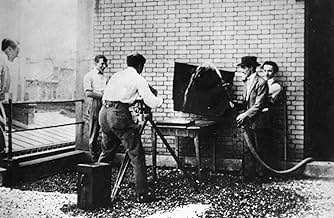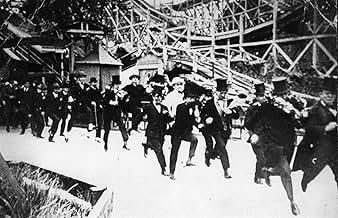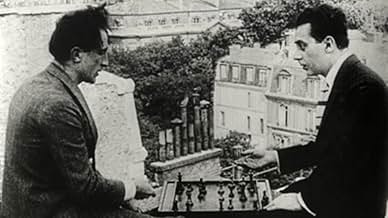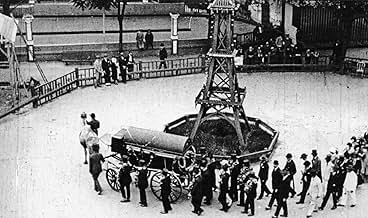Entr'acte
- 1924
- 22min
NOTE IMDb
7,3/10
4,3 k
MA NOTE
Un film absolument dada. Quelqu'un est tué, son cercueil devient incontrôlable et, après une poursuite, il s'arrête. La personne en sort et laisse tous ceux qui ont suivi le cercueil dispara... Tout lireUn film absolument dada. Quelqu'un est tué, son cercueil devient incontrôlable et, après une poursuite, il s'arrête. La personne en sort et laisse tous ceux qui ont suivi le cercueil disparaître.Un film absolument dada. Quelqu'un est tué, son cercueil devient incontrôlable et, après une poursuite, il s'arrête. La personne en sort et laisse tous ceux qui ont suivi le cercueil disparaître.
Inge Frïss
- La ballerine
- (as Mlle Frïss)
Man Ray
- Un joueur d'échecs
- (as Man-Ray)
Marcel Achard
- Un homme qui suit le corbillard
- (non crédité)
Georges Auric
- Un homme qui suit le corbillard
- (non crédité)
Georges Charensol
- Un homme qui suit le corbillard
- (non crédité)
Georges Lacombe
- Un homme qui suit le corbillard
- (non crédité)
Roger Le Bon
- Un homme qui suit le corbillard
- (non crédité)
Jean Mamy
- Un homme qui suit le corbillard
- (non crédité)
Rolf de Maré
- Un homme qui suit le corbillard
- (non crédité)
Erik Satie
- Un homme qui charge le canon
- (non crédité)
Pierre Scize
- Un homme qui suit le corbillard
- (non crédité)
Louis Touchages
- Un homme qui suit le corbillard
- (non crédité)
Histoire
Le saviez-vous
- AnecdotesThe ballet "Relâche" ("Theatre Closed") premiered at the Théâtre des Champs Elyseés in Paris on December 4, 1924. Based on a book and with settings by Francis Picabia, it was a ballet in two acts commissioned and staged by the Ballets Suédois of Rolf de Maré, with choreography by Jean Börlin. As the title "Entr'acte" implies, this film was shown between the two acts, with music by Erik Satie.
- GaffesObvious stand-in for the close-up of Rolf de Maré getting kicked in head, which sends him (via reverse motion) flying back into the end title. The "kick" itself is clearly achieved through reverse motion.
- Versions alternativesThere is an Italian edition of this film on DVD, distributed by DNA Srl (2 Films on a single DVD). The film has been re-edited with the contribution of film historian Riccardo Cusin. This version is also available for streaming on some platforms.
- ConnexionsEdited into Avant-garde Cinema (1960)
Commentaire à la une
We were shown this film in a class where at least once during each class, I start to nod off to sleep. Maybe it's the time of day, or the too-dark lights, but even during one of the Jean Vigo films we saw it didn't grab me. This one did, however, as it is one of the best short films of the 20's, or at least one of the more ambitious ones of the time. There are plenty of Freudian symbols, or maybe spoofs and in-jokes on the symbols (i.e. phallic imagery, cannons, guns, balls, and obsessions with looking up women's skirts).
But more importantly there is an almost need to break through anything expectable. Unlike Bunuel's Un Chien Andalou, however, Entr'acte even goes for the manic and cartoon-like. Like Bunuel's film, there COULD be a certain thread of a story in the proceeding, if you try to take one to mind- here the story could be the unexpected tragedy of death turned up on its own head. However there is also the latter part of the film, which involves a large group running after (in trademark, hilarious fast-motion film) a hearse running down a road. It's a kind of peak of stimulating silent-film cinema, where everything being done can now be just as easily done- and is- on a daily basis by music video directors.
Yet Clair is so inventive with his techniques, of pushing a speed and tempo with his style, that it works well despite making no sense on the surface. It's a film made in the heights of French impressionism and surrealism, and the almost sheer confidence of the filmmaker here propels it into being unforgettable in a way. Most will seek out the Bunuel early works first, of course, but along the way this is worth a shot. At the least, you'll have your own interpretation once its done, not shoved down your throat.
But more importantly there is an almost need to break through anything expectable. Unlike Bunuel's Un Chien Andalou, however, Entr'acte even goes for the manic and cartoon-like. Like Bunuel's film, there COULD be a certain thread of a story in the proceeding, if you try to take one to mind- here the story could be the unexpected tragedy of death turned up on its own head. However there is also the latter part of the film, which involves a large group running after (in trademark, hilarious fast-motion film) a hearse running down a road. It's a kind of peak of stimulating silent-film cinema, where everything being done can now be just as easily done- and is- on a daily basis by music video directors.
Yet Clair is so inventive with his techniques, of pushing a speed and tempo with his style, that it works well despite making no sense on the surface. It's a film made in the heights of French impressionism and surrealism, and the almost sheer confidence of the filmmaker here propels it into being unforgettable in a way. Most will seek out the Bunuel early works first, of course, but along the way this is worth a shot. At the least, you'll have your own interpretation once its done, not shoved down your throat.
- Quinoa1984
- 6 févr. 2006
- Permalien
Meilleurs choix
Connectez-vous pour évaluer et suivre la liste de favoris afin de recevoir des recommandations personnalisées
Détails
- Durée22 minutes
- Couleur
- Mixage
- Rapport de forme
- 1.33 : 1
Contribuer à cette page
Suggérer une modification ou ajouter du contenu manquant

Lacune principale
By what name was Entr'acte (1924) officially released in Canada in English?
Répondre









